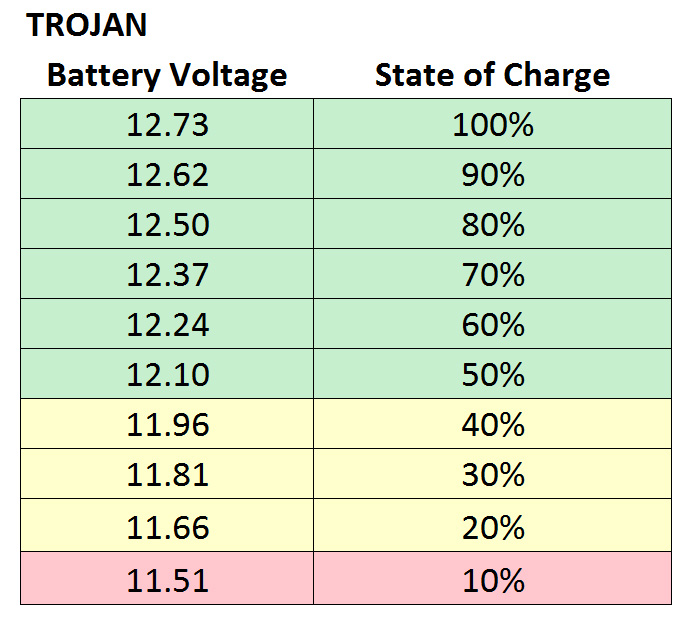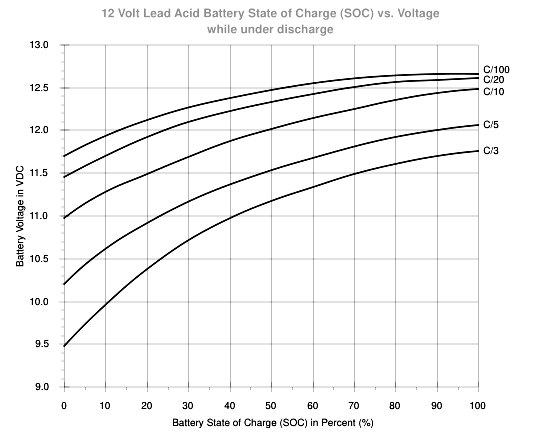Table of Contents
Depth of discharge / State of Charge
Depth-of-discharge (DoD or DOD) refers to how low a deep cycle battery is taken between full charges. Specifically, what percentage of the rated capacity remains at a given point? Example: For solar powered systems the greatest DoD (and therefore lowest SoC) will be in early morning just before the panels start creating power again.
DoD is the inverse of State of Charge (SoC). Example: a battery at 30% DoD is at 70% SoC.
Note: This information is primarily relevant to lead-chemistry batteries. Lithium batteries have different DoD capabilities and lifecycles.
knowing when SoC is 100% (fully charged)
With lead batteries we know the battery is 100% when
- we are holding Absorption voltage; and
- current acceptance has decreased to 0.02C, or about 2% of the rated capacity
So for a 225Ah Trojan T-105 that might be when current acceptance drops to 4.5A at 14.8v. Some solar charge controllers have a setting for defining the final current acceptance (“trailing amps”, “endAmps”). Usually humans observe system behavior and set an Absorption duration likely to terminate at about the correct time.1)
Mythbusting: although it is a common saying, a lead battery is not reliably 80% SoC when Absorption voltage is reached. See this article for why this is so.
With lithium batteries humans might use use amp-counting with a battery monitor but most charge controllers don't talk to battery monitors. So we can take one of two major approaches:
- at moderate charging rates like 0.2C2) SoC will be ~100% when voltage rises to 14.0v
- at moderate charging rates SoC will be ~100% when voltage rises to 13.8v and we add perhaps 30 minutes of Absorption duration. At that point current acceptance will fall off to somewhere between 0%-10%.
- at moderate charging rates and voltages between ≥13.4v and <13.8v SoC will be ~100% after some amount of Absorption. It could take a day at 13.4v and a few hours at 13.6v; watch your battery monitor to see when acceptance actually falls off.
soft and firm charging
Solar is typically a moderate (or “soft”) charging source so the guidelines above are probably close enough to start from. Alternator charging from combiner or large DC-DC may be high (“firm”) enough for SoC estimates to be artificially high.
So while we can say with confidence that a 100Ah Li battery charged at 20A to 14.0v will be ~100% SoC, the same battery charged to 14.0v at 80A might only be at 75% SoC. And it could get damagingly overcharged if charged to 14.0v very gently at something like 5A.3)
The amp counter will probably help here during charging although even it can be thrown off; see the battery monitor article for more on this.
estimating SoC while resting
 A rested (no load), fully charged, unFloated lead battery will be 100% around 12.7v-12.8v; see specs for exact numbers. We can only reasonably assess SoC by voltage after a full charge. After charging is removed the lead battery will start to self-discharge (drain itself), which is why lead batteries require Float charging. A lead battery that has been fully charged and at Float voltage ever since is assumed to be 100%.
A rested (no load), fully charged, unFloated lead battery will be 100% around 12.7v-12.8v; see specs for exact numbers. We can only reasonably assess SoC by voltage after a full charge. After charging is removed the lead battery will start to self-discharge (drain itself), which is why lead batteries require Float charging. A lead battery that has been fully charged and at Float voltage ever since is assumed to be 100%.
The famous chart to the right is used to estimate SoC of a rested battery after a full charge.
A rested (no load), fully charged, unFloated lithium battery will be 100% around 13.5-13.6v. Even with charging removed lithium self-discharge is very low. The downside of this is that an overcharged Li battery can stay at unhealthy high levels for long periods before self-discharging to a safer range.
As we will see below SoC-by-voltage will appear to be artificially high during charging4) and artificially low during discharging5). With some “seat time” on your system you may learn how to interpolate with some degree of accuracy.
SoC by specific gravity
“The truest measure of a [lead chemistry] battery's state of charge is the specific gravity of the battery acid.” – Rolls battery.6)
Only flooded-type batteries are practical for SoC assessment by SG of the electrolyte. Needed for this operation:
- temperature of the battery
- SG chart from the battery manufacuturer
SoC by amps
A battery monitor, usually a amp/coulumb counter with a shunt, will measure the current going to/from the battery. It will often show real-time current flow and a state of charge percentage. It may also show voltage (see below).
Note that deep cycle battery capacities are given at the “20 hour rate”, roughly depleting the battery over the course of a day/night cycle. Heavier loads will cause apparent capacity to decrease. Lithium is much less susceptible and tends to deliver more predictable capacity.
SoC by voltage
Note: read this article by mainesail
100% SoC (~12.7v) is measured after the bank has been fully charged and then rested. It is measured “on the way down”; measuring “on the way up” while charging will lead to false confidence and leaving the battery less than fully charged.
The voltage level associated with 50% DoD is widely discussed. 12.1v rested is generally used as 50% State of Charge (SoC). A more conservative approach uses 12.2vdc rested.
Since resting is rare in most practical scenarios stopping at 12.2vdc under light loads would be a practical approach. DC expert SternWake7) says: “…those who are loading their battery and stop at 12.2v are treating their battery better, just not using all the capacity they could and perhaps seriously inconveniencing themselves by thinking they need to stop at this point, especially if the loads are fairly large, like while running a laptop and watching tv and while their fridge compressor is running.”8)
By this yardstick both of these uses should keep DoD from going beyond 50%:
- constant light loads with measured >=12.2v
- intermittent heavier loads that leave the system with measured >=12.2v when that load is removed
estimating SoC while discharging
The more challenging task is judging SoC (including for LVD purposes) under heavier loads.
Consider this chart for Trojan FLA batteries:
For a 200A bank 50% DoD would be 12.1v at rest, ~12.0v at C/10 (20A discharge), ~11.55v at C/5 (40A discharge), and 11.2v at C/3 (~70A discharge).
It may take experimentation with your system to see where the battery voltage rebounds after removing the heavy loads. An approach might be:
- apply expected load
- run battery down to 11.5v (then 11.25, 11, 10.75, 10.5 etc until battery no longer rebounds to 12.1-12.2v)
- remove load
- observe battery voltage
If the battery rebounds to the desired voltage then repeat to deeper discharge. Stop when the battery no longer can rebound to the setpoint. The LVD voltage is the lowest voltage the system can drop to and still rebound to the desired setpoint when the load is removed.
Lithium batteries also exhibit voltage sag under load but typically much less than AGM or especially FLA. An amp-counting battery monitor is the most accurate tool here.
estimating SoC while charging
Similar to voltage sag during discharge, batteries exhibit voltage surge or rise during charging. As with discharge, the effect is very strong with FLA, medium with AGM, and lowest with Lithium.
partial state of charge
This section has moved.
effect of DoD on lead battery life
DoD has a significant impact on longevity of lead deep cycle batteries.9) For this reason Inverters and other high-load devices may have a low voltage cutoff to prevent going below a given SoC, typically 50%. Since this is judged by voltage it is am imperfect science.
The most common discharge limit for deep cycle batteries is 50% DoD. This gives a good balance between usability and longevity. The lowest cost per Ah occurs around 30% DoD although this requires buying, installing, and moving dead lead or unusable battery capacity.
Based on the following data on the Trojan T-105:
- lowest cost per Ah happens at 30% DoD
- longest life happens at 20% DoD
- least battery weight happens at 80% DoD
so make your DoD decision based on what is most important to you.
| T105 Ah | Cost | weight per set | Target Ah | |||||
| 225 | $260.00 | 124 | 175 | |||||
| DoD | State of Charge | power per cycle | Num. of cycles | lifetime power in kAh10) | levelled cost / Kah | life in years | Sets needed for target Ah | Weight |
| 10 | 90 | 22.5 | ||||||
| 20 | 80 | 45 | 3000 | 135 | $1.93 | 8.2 | 3.9 | 482 |
| 30 | 70 | 67.5 | 2250 | 151.875 | $1.71 | 6.2 | 2.6 | 321 |
| 40 | 60 | 90 | 1450 | 130.5 | $1.99 | 4.0 | 1.9 | 241 |
| 50 | 50 | 112.5 | 1200 | 135 | $1.93 | 3.3 | 1.6 | 193 |
| 60 | 40 | 135 | 1050 | 141.75 | $1.83 | 2.9 | 1.3 | 161 |
| 70 | 30 | 157.5 | 900 | 141.75 | $1.83 | 2.5 | 1.1 | 138 |
| 80 | 20 | 180 | 800 | 144 | $1.81 | 2.2 | 1.0 | 121 |
One can choose to run the batteries quite hard in emergency or temporary conditions with the understanding that it will likely “hurt” the batteries to some degree. Consistently going past 50% DoD will greatly reduce the battery's usable cycles. Some studies suggest discharging to 80% yields 1/10th the number of cycles available at 20%.
lithium SoC
Lithium chemistries have very flat voltage curves, making it notoriously difficult to gauge SoC by voltage. In this case a shunted battery monitor is used to count amps as they go in/out. If the Li battery has connectivity you may be able to read SoC from the internal BMS.


